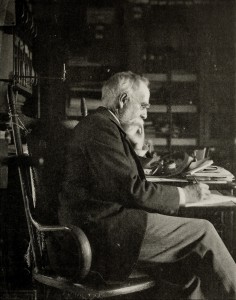Coleman Sellers Biography 1827–1907 Page 2
EMPLOYMENT [1844 – 1873]
In 1846, at the age of nineteen, he was offered employment in the Globe Rolling Mill, in Cincinnati, Ohio, operated by his elder brothers, Charles and George Escol Sellers. There his first work was the preparation of a set of drawings of the improved machinery of a mill for Horatio Allen, of the Novelty Iron Works, of New York. When these drawings were completed, he applied himself diligently to acquiring knowledge of all the processes incident to rolling merchant iron, wire rods and the flat rails used at that time on the railroads of the West. Connected with the establishment was quite an extensive wire mill which underwent some improvement under his direction, and while engaged in making wire for O’ Reilly, who was then called the Telegraph King of the West, he procured from him a few cells of the battery used on the telegraph outfits of the day and filled his spare time in repeating the experiments that had been announced by Faraday and others, making all the apparatus required for these electrical experiments with neatness and precision.
Instrument Designed To Illustrate Faraday’s Tangential Force Of Magnetism. Made By Coleman Sellers When 20 Years Old
He gathered around him a small coterie of men interested in science, who looked to him to explain and illustrate the new discoveries as they were announced from time to time, and thus we find him, at the age of nineteen, lecturing informally to his friends on Faraday’s experiments, and even elucidating Swedenborg’s Principia. Botany, mineralogy, and conchology, in a country where the streams were filled with interesting shells, gave an object to his rambles, and made him the more observant when engaged in the preliminary survey of a railroad from Covington to Lexington, Ky. , afterwards known as the Kentucky Southern. The limestone rocks of Cincinnati’s numerous hills were rich in small fossils, and his collection included many perfect specimens.
Before Dr. Sellers reached the age of twenty-one he was superintendent and manager of the Globe Rolling Mills, and during 1850 and 1851 he was engaged by his elder brother in building locomotives of the latter’ s invention for use on the Panama Railroad. Upon the completion of these engines, late in 1851, he went into the service of James and Jonathan Niles, became foreman of their locomotive works in Cincinnati, and retained this position until 1856, when he accepted an offer from his kinsmen, William Sellers & Co., of Philadelphia, to take charge of their draughting room. His experience as a locomotive builder had strongly impressed him, with the demand that then existed for better machine tools to reduce the cost of locomotives and improve the quality of the work particularly the need of special tools designed for that service, and he found in his new business ample opportunity to work out his ideas and to further develop and apply his ability as an engineer and investor.
He retained this position for over thirty years, during which time he designed a great variety of machinery, covering all the usual machine tools and a large number of special machines for various purposes, his firm having constructed at different times many mechanical appliances not strictly classable as machine tools. In this way he extended his experience over a large field, embracing a great variety of hydraulic machinery, cranes, hoists and elevators, presses and forging machines, engines, pumps, and injectors, turn-tables and pivot bridge, and much else. [continue]

